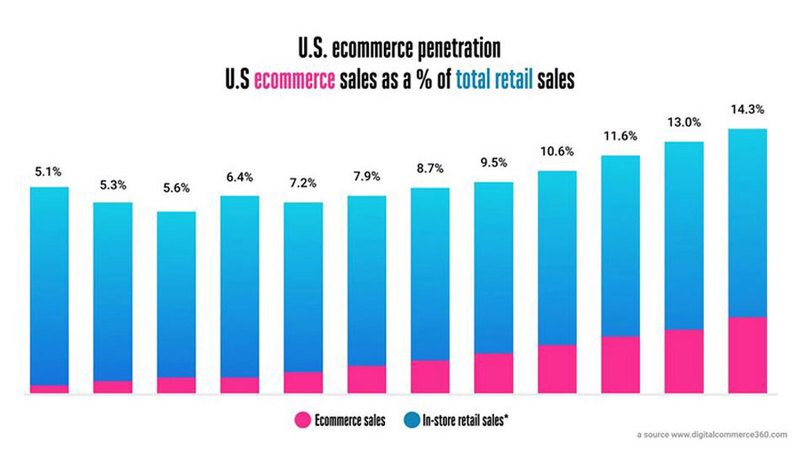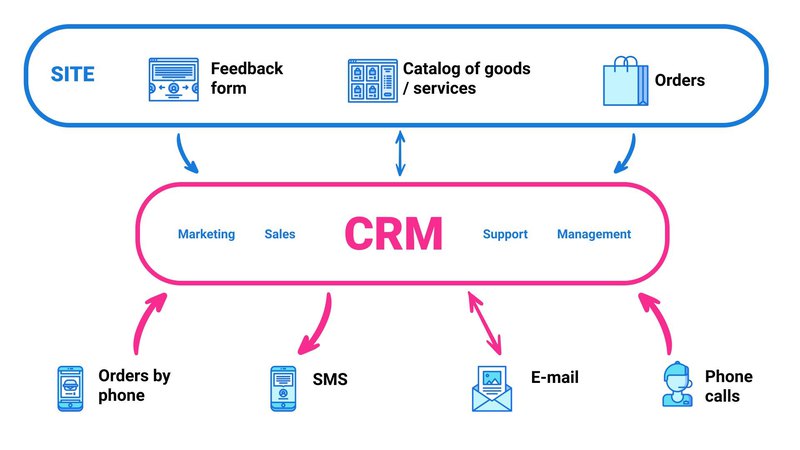Skip ahead
Modern websites can consist of one page or dozens of pages. However, creating a content-rich website is no longer enough to become successful. It is hard to imagine a website without a newsletter subscription form, online payment options, and other services that have become the norm. In other words, websites rarely work in isolation. They interact with other sites, applications, and internal CRM systems implemented by the site owner to make information on the site easy to find.
Have you been asking yourself
“What is integration”?
Integration of a website with another service is an automatic data exchange between your website and this service. They allow you to solve internal business problems like stock count based on your online sales, paper work, etc. Even if your business requires unique solutions, you can obtain custom CRM software to match any of your business processes.
In this article, we are going to discuss the answer, the most popular types of integrations that our clients often want to see on their websites, and the business goals they help achieve.
Payment Gateway Integration for Your E-Commerce Website
Due to the continuing growth of e-commerce over the past twenty years, payment gateway integration has become one of the most common integrations for e-commerce sites. The e-commerce market in the US is constantly growing. According to the US Department of Commerce, in 2018, consumers spent $513.61 billion on online purchases — a 14.2% increase compared to 2017. If you have decided to sell your products or services online, then you definitely need an integrated payment system.

Payment integration allows you to complete many important tasks online, such as paying for select products and managing customer transactions. Instead of transferring payments, payment gateways verify the funds transferred to the seller, ensuring a safe and secure online transaction. When it comes to automating the payment process on a website, you need to take your time exploring various features of different payment systems. You should check the transition fees, as well as the types of cards and payments the system accepts. You must also make sure that the authorization process is not overly complicated, learn how many currencies are supported by the payment gateway, and find out about the market leaders.
Ultimately, there are two main payment gateway integration methods:
- Set up each payment system separately. This option is ideal in the case of large volumes of transactions, if the commission fee to the aggregator exceeds the cost of developing integration solutions for each payment system.
- Process transactions via payment aggregators. In most cases, it is advised to integrate online payment systems into your website through aggregators. The cost of transactions for certain types of payments is the same for both the aggregators and the payment system, since the former are often offered reduced rates.
Please note that data processing systems have certain security requirements that the site owner is obligated to fulfill. These requirements can be found on the official website of the processing system.
Integration with Email Newsletter Services
Email newsletters are often used by businesses that sell products and services via their website or actively work with customers online. One in three of our clients use email newsletters. Every website has contact forms for collecting user data. Email addresses provided by users are placed on email newsletter distribution lists.
When integrating email newsletter services into your CRM system, you get an opportunity to work with newsletters from the admin panel of your site. All user email addresses collected through the contact forms on your site will be transferred to the email newsletter service and added to the next newsletter. The main goal of email integration is to simplify the work with user email addresses and make users go back to the site again. At Direct Line Development, we also prepare a letter template that is sent to website users in the newsletter.
Email integration is convenient because of the ability to create a customer base from contact forms collected from your site. Let’s say a visitor requests a call back regarding a specific service or product. An email message informs the administrator of the request, which helps him or her continue working with the client on time and also adds the client’s contact information to automated newsletters.

When choosing this type of integration, you should pay attention to the content of your newsletters and how frequently they are sent. The newsletters should be interesting to the clients and also include an unsubscribe link.
Integration with Google Services for Better User Experience
Google provides a variety of services that can be built into a website to increase its capabilities. Integration with Google comments helps improve your SEO promotion. Comments can be moderated from the admin panel of your site. Google Calendar is another useful tool that allows you to set up events with clients in the most convenient way, and it also provides an opportunity to register for an event directly on the site.

Important: When choosing Google integration, you should be ready to devote time to work in the admin panel. Reviews should appear on your site on time and your calendar events should be updated so that the site stays current.
CRM Integration with Website as the Most Important Part of Excellent Customer Service
CRM integration with website is critical for any business. The system automates internal business processes, provides data exchange between departments, and reduces paperwork. Almost all CRM systems have an API — an interface for exchanging data with third-party services. Additionally, you can use this interface to exchange data between the site and the CRM system.
Properly configured CRM integration with website increases your sales. This is achieved by quality communication with existing and potential customers. CRM software is able to collect contact information through forms on the site, easily track client’s actions, and more.

Large corporate players are not the only ones who can benefit from CRM systems. Small and medium-sized businesses all over the country are already taking full advantage of effective CRM modules on their websites. Another great thing about a CRM system is that it provides well-organized user data, which leads to improved sales.
CRM implementation can lead to critical sales results for your business. Here are some of them:
- The average return on investment for CRM is $8.71 for every dollar spent. (source: Nucleus Research)
- A CRM tool can increase revenue by 41% per salesperson.
- CRM systems are known to improve customer retention by as much as 27%.
- About 65% of businesses adopt a CRM system within their first 5 years.
It is important to describe in detail how integration should work, which data should be displayed on the site, and which should be transferred to the CRM system. Our project managers meticulously collect all the integration data so that our developers will implement the information as needed.
Custom Integration Systems and Software
All businesses have their own unique needs. Currently, many narrow, specialized solutions have been developed for various business sectors. In order to provide business owners with quality custom integration systems, it is critical to conduct thorough research on processes that integrate into external systems and applications. For instance, let’s say one of our clients wants more of his or her customers to book karting and axe throwing services online. We would need to integrate the site with special software for activity centers that are not a part of the client’s website.
This process involves active participation from the client, studying his or her price lists, as well as the capabilities of the API-specialized booking system for racing tracks. By utilizing custom integration systems, you can make your website more appealing and stand out from the crowd of competitors. In most cases, a client finds website integration to be an extremely useful tool. Such integration is the beginning of tight, positive cooperation with a provider. After trying custom integration, clients usually want to further explore its functionality.
Important: Custom integration requires a lot of various data about the service that should be added to your site. Ensure that you DO NOT accidentally disclose any corporate information or trade secrets.
Conclusion
With properly chosen website integrations, you can make all your business processes and regular interactions with customers easier. Our team at Direct Line Development is always ready to hear your thoughts and suggestions regarding your future website. We can help you find the right website integrations for your business!





Comments